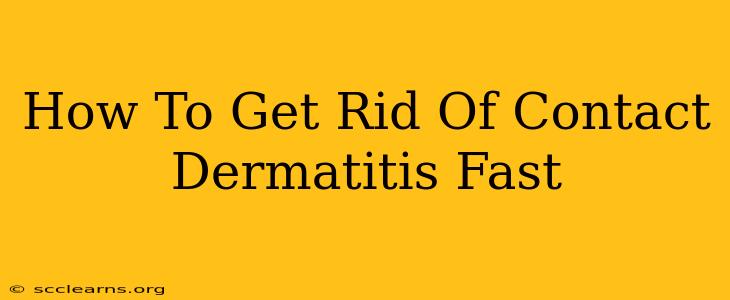Contact dermatitis—that itchy, inflamed skin reaction—can be incredibly frustrating. But don't despair! While there's no magic cure, there are several effective ways to alleviate symptoms and speed up healing. This guide provides practical tips and home remedies to help you get rid of contact dermatitis fast.
Understanding Contact Dermatitis
Before diving into treatment, it's important to understand what causes contact dermatitis. This skin condition arises from direct contact with an allergen (allergic contact dermatitis) or irritant (irritant contact dermatitis). Common culprits include:
- Plants: Poison ivy, oak, and sumac are notorious offenders.
- Metals: Nickel, found in jewelry and other items, is a frequent culprit.
- Cosmetics and skincare products: Certain fragrances, preservatives, and chemicals can trigger reactions.
- Cleaning products: Harsh chemicals in household cleaners can irritate the skin.
- Rubber: Latex is a common allergen.
Fast Relief Strategies for Contact Dermatitis
The key to getting rid of contact dermatitis quickly is to address the inflammation and itching while preventing further irritation. Here’s what you can do:
1. Identify and Eliminate the Irritant
This is the most crucial step. Once you've identified the substance causing the reaction, avoid all future contact. This might involve changing detergents, switching jewelry, or carefully reading product labels.
2. Cool Compresses: Your First-Aid Solution
Applying cool, wet compresses to the affected area several times a day can significantly reduce itching and inflammation. The coolness soothes the skin and helps constrict blood vessels, minimizing swelling.
3. Oatmeal Baths: Soothing Relief
Colloidal oatmeal baths are a gentle and effective way to calm irritated skin. The oatmeal's anti-inflammatory properties help reduce itching and promote healing. Add a cup or two of colloidal oatmeal to a lukewarm bath and soak for 15-20 minutes.
4. Over-the-Counter (OTC) Medications
Many effective OTC treatments can provide rapid relief:
- Hydrocortisone cream (1%): This topical steroid cream reduces inflammation and itching. Apply as directed.
- Calamine lotion: This soothing lotion helps relieve itching and dryness.
- Antihistamines (oral): Oral antihistamines, like diphenhydramine (Benadryl), can help reduce itching, especially at night. Be aware of potential drowsiness.
5. Moisturize, Moisturize, Moisturize!
Keeping the affected area well-hydrated is essential for healing. Use a fragrance-free, hypoallergenic moisturizer several times a day to prevent dryness and cracking.
When to See a Doctor
While many cases of contact dermatitis can be managed at home, it's important to seek professional medical attention if:
- Symptoms are severe: Extensive rash, severe itching, or significant swelling warrant a doctor's visit.
- Home remedies aren't effective: If your symptoms persist or worsen despite home treatment, consult a dermatologist.
- You suspect an infection: Signs of infection, such as pus, increased redness, or fever, require immediate medical care.
Preventing Future Outbreaks
Prevention is key to avoiding future episodes of contact dermatitis. Consider these preventative measures:
- Wear gloves: When handling potential irritants, such as cleaning products or gardening, always wear gloves.
- Patch testing: If you suspect an allergy, consider patch testing to identify specific allergens.
- Read labels carefully: Pay close attention to ingredient lists on cosmetics, lotions, and other products.
By following these tips and seeking professional help when needed, you can effectively manage contact dermatitis and get back to feeling your best. Remember, early intervention is crucial for faster relief.

